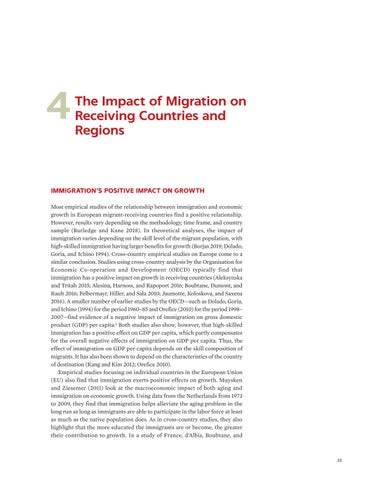4
The Impact of Migration on Receiving Countries and Regions
IMMIGRATION’S POSITIVE IMPACT ON GROWTH Most empirical studies of the relationship between immigration and economic growth in European migrant-receiving countries find a positive relationship. However, results vary depending on the methodology, time frame, and country sample (Rutledge and Kane 2018). In theoretical analyses, the impact of immigration varies depending on the skill level of the migrant population, with high-skilled immigration having larger benefits for growth (Borjas 2019; Dolado, Goria, and Ichino 1994). Cross-country empirical studies on Europe come to a similar conclusion. Studies using cross-country analysis by the Organisation for Economic Co-operation and Development (OECD) typically find that immigration has a positive impact on growth in receiving countries (Aleksynska and Tritah 2015; Alesina, Harnoss, and Rapoport 2016; Boubtane, Dumont, and Rault 2016; Felbermayr, Hiller, and Sala 2010; Jaumotte, Koloskova, and Saxena 2016). A smaller number of earlier studies by the OECD—such as Dolado, Goria, and Ichino (1994) for the period 1960–85 and Orefice (2010) for the period 1998– 2007—find evidence of a negative impact of immigration on gross domestic product (GDP) per capita.1 Both studies also show, however, that high-skilled immigration has a positive effect on GDP per capita, which partly compensates for the overall negative effects of immigration on GDP per capita. Thus, the effect of immigration on GDP per capita depends on the skill composition of migrants. It has also been shown to depend on the characteristics of the country of destination (Kang and Kim 2012; Orefice 2010). Empirical studies focusing on individual countries in the European Union (EU) also find that immigration exerts positive effects on growth. Muysken and Ziesemer (2011) look at the macroeconomic impact of both aging and immigration on economic growth. Using data from the Netherlands from 1973 to 2009, they find that immigration helps alleviate the aging problem in the long run as long as immigrants are able to participate in the labor force at least as much as the native population does. As in cross-country studies, they also highlight that the more educated the immigrants are or become, the greater their contribution to growth. In a study of France, d’Albis, Boubtane, and
35

